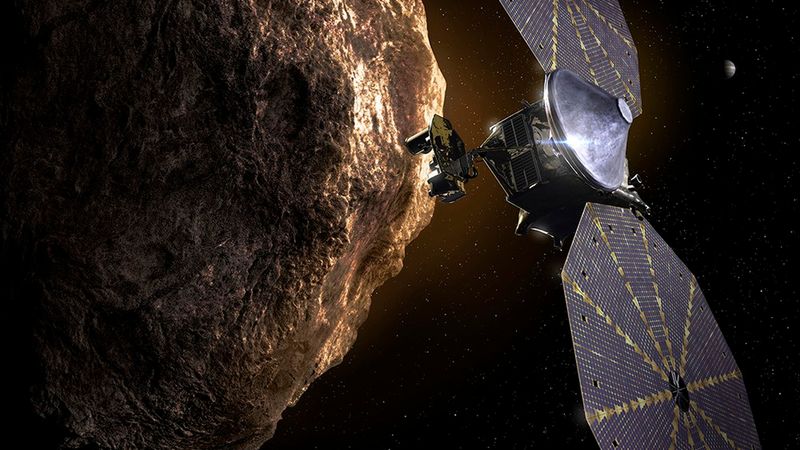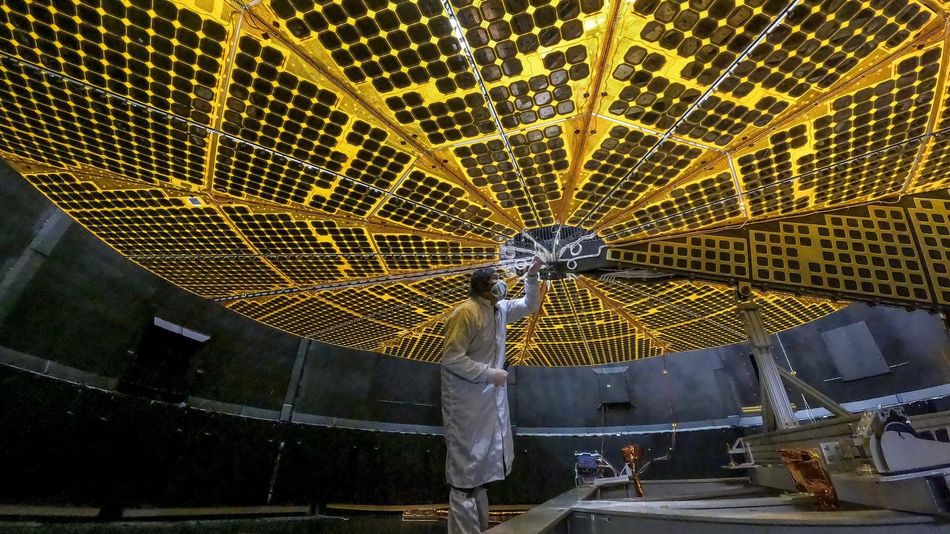Lucy spacecraft to fly by asteroid Donaldjohanson this Easter
On 20 April 2025, NASA's Lucy spacecraft will fly past asteroid (52246) Donaldjohanson, which measures nearly four kilometres in diameter, at a distance of 960 kilometres.

Asteroid flyby for NASA's Lucy mission. An artist's impression of NASA's Lucy spacecraft approaching the asteroid (52246) Donaldjohanson, which measures nearly four kilometres across. Lucy’s flyby on 20 April 2025, at a distance of 960 kilometres and a speed of 13.4 kilometres per second, will serve as a dress rehearsal for the study of the trojan asteroids in Jupiter's orbit, which the probe will reach in 2027/28 and again in 2033. The science team expects the satellite images of Donaldjohanson to reveal features as small as 50 metres. Credit: NASA/GSFC
This article was first published on
www.dlr.deOn Easter Sunday, at 19:51 CEST, NASA's Lucy spacecraft will perform a close flyby of the asteroid (52246) Donaldjohanson, at a distance of just under 1000 kilometres. The flyby distance has been precisely calculated to allow the L'LORRI camera system to capture sharp, blur-free images despite the spacecraft's high relative speed. This will enable detailed images to be taken with a resolution of up to ten metres per pixel, capable of showing features as small as 50 metres. Donaldjohanson is approximately four kilometres in diameter and resides within the main asteroid belt between Mars and Jupiter. The German Aerospace Center (Deutsches Zentrum für Luft- und Raumfahrt; DLR) is involved in the Lucy mission and will begin analysing images and data immediately following the flyby.
A high degree of precision is required for the flyby, which will take place approximately 225 million kilometres from Earth. "Lucy will shoot past its target at 13.4 kilometres per second," explains Stefano Mottola from the DLR Institute of Planetary Research and a member of the Lucy science team. "That's nearly 50,000 kilometres per hour. This is why we observed Donaldjohanson from a great distance using the camera system over a 39-day period in February and March. On the one hand, this allowed us to better characterise the asteroid; on the other, we were able to refine the spacecraft's trajectory if necessary. That turned out not to be needed – Lucy remained precisely on course." The radio signal from Lucy will take 12.5 minutes to reach Earth.
This existing sequence of optical navigation images illustrates how Donaldjohanson brightens as the spacecraft draws nearer. In a kind of time-lapse flipbook, successive images – each with a field of view of 0.3 degrees – are superimposed to show Lucy's approach. At the start of the sequence, Lucy was still more than 72 million kilometres away from the asteroid; by the end, the distance had closed to just 25 million kilometres.
Automatic camera tracking for optimal image capture
To make optimal use of the L'LORRI (Lucy Long Range Reconnaissance Imager) camera system’s image sensor at the planned distance – meaning to keep as much of the asteroid's surface in the centre of each frame as possible – the spacecraft is equipped with a Terminal Tracking System (TTS). By automatically adjusting the camera's alignment to maintain focus on the target, the TTS locks on to the asteroid during the approach. "This worked extremely well during the first asteroid flyby in November 2023," says Mottola, confident that the system will perform just as reliably during Lucy's second close asteroid encounter. "The TTS enables us to make full use of the camera's field of view when imaging the target." In addition to this second test of both the TTS and the L'LORRI, which was developed by the Applied Physics Laboratory at Johns Hopkins University in Maryland, USA, the spacecraft's four other scientific instruments will also be activated to take measurements. The DLR Institute of Planetary Research will use the image data to generate digital terrain models, allowing scientists to determine the asteroid's shape and map its topography. The Institute will also contribute to the scientific interpretation of the images.
In Lucy's navigation images taken in February and March, the spacecraft was also able to detect periodic fluctuations in Donaldjohanson's brightness, caused by the asteroid's rotation, superimposed on the overall brightening as the asteroid draws nearer. The brightness fluctuations suggest that Donaldjohanson is elongated and rotates slowly, but this hypothesis can only be confirmed following detailed analysis of the images captured during the encounter on 20 April. During the spacecraft's long approach, Donaldjohanson will remain an unresolved point of light. The first visible surface details will only emerge on the day of the flyby.
Will the science team be in for another surprise?
In November 2023, Lucy successfully flew by the small main-belt asteroid Dinkinesh, which measures just 800 metres across, and discovered a 220-metre moon orbiting it, later named Selam. But the surprises did not end there. After the encounter, Lucy looked back and captured images revealing that Selam is in contact with its own small moon, making it a contact binary – two objects stuck together as one. If Donaldjohanson were also revealed to be a binary asteroid, like Dinkinesh, it would be a significant and unexpected discovery that would support the growing hypothesis that binary systems are far more common in the main asteroid belt than previously assumed.
Asteroid Donaldjohanson was discovered in 1981 by American astronomer Schelte John Bus at the Siding Spring Observatory in Australia. It is named after anthropologist Donald Johanson, who famously discovered the fossilised skeleton of a human ancestor known as 'Lucy'.
NASA's Lucy mission is itself named after this landmark find. Donald Johanson – born in 1943 – led a 1974 expedition to Ethiopia’s Afar Triangle near the Red Sea. There, he and his students unearthed the 3.2-million-year-old remains of an early 'pre-human', later classified as Australopithecus afarensis in the field of anthropology. The Donaldjohanson asteroid orbits the Sun approximately every three years, at a distance ranging from 291 to 420 million kilometres. Its orbit is tilted at 4.3 degrees relative to the ecliptic – the plane of Earth's orbit around the Sun.
Lucy will reach Jupiter's asteroids in 2027
Lucy is one of NASA's Discovery-class missions, launched on 16 October 2021. Its primary targets are the trojan asteroids located in Jupiter's orbit, which circle the Sun at the gravitationally stable L4 and L5 Lagrange points – 60 degrees in front of and behind the giant planet. Relatively little is known about these two groups of asteroids. They may differ in composition from the main belt asteroids, and some scientists speculate they have a different origin. It is possible they formed beyond the orbits of Jupiter and Saturn, and may even originate from the Kuiper Belt – a distant, doughnut-shaped region of icy bodies located between five and ten billion kilometres from the Sun. Lucy will observe six of these objects in Jupiter's orbit between 2027 and 28, and two more in 2033. After twelve years, Lucy will have closely observed a total of eleven asteroids.
